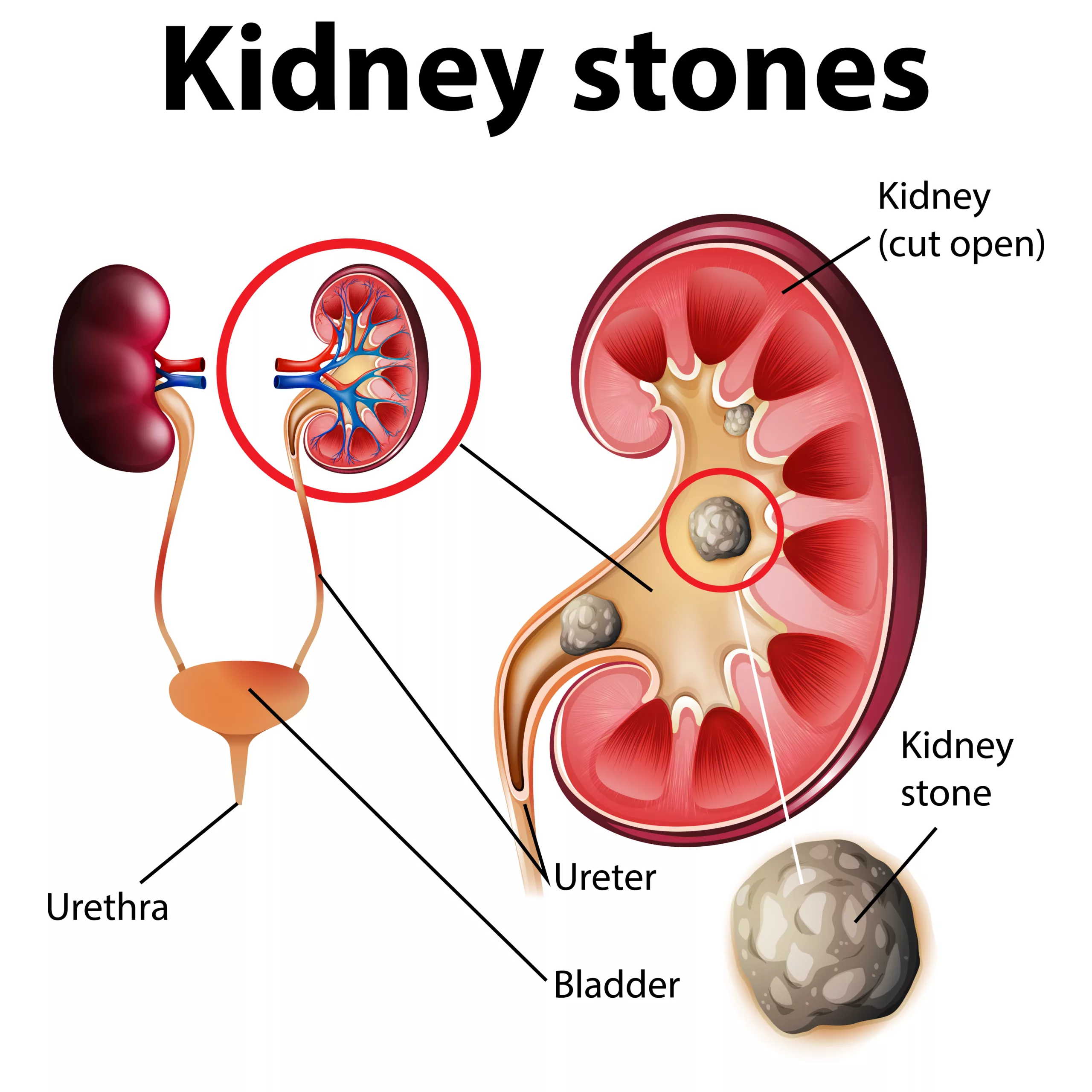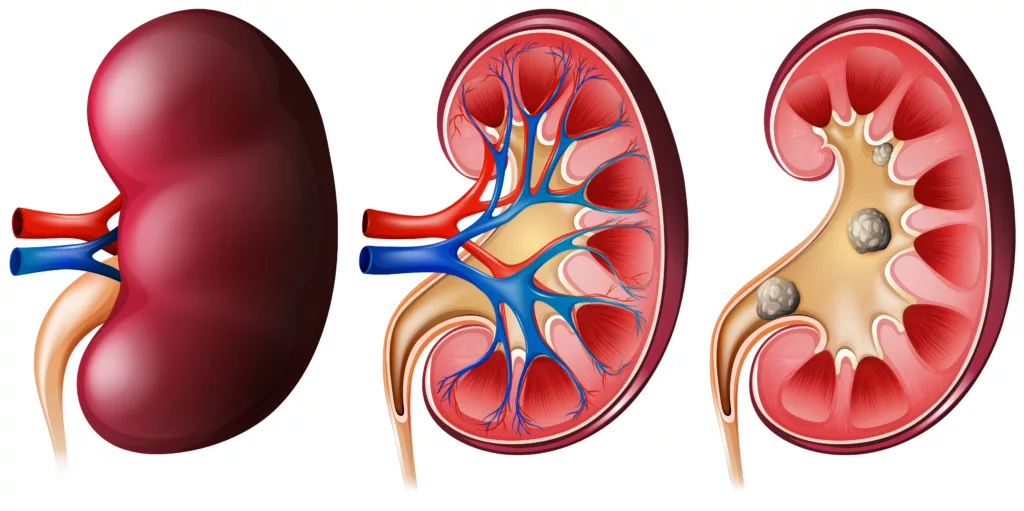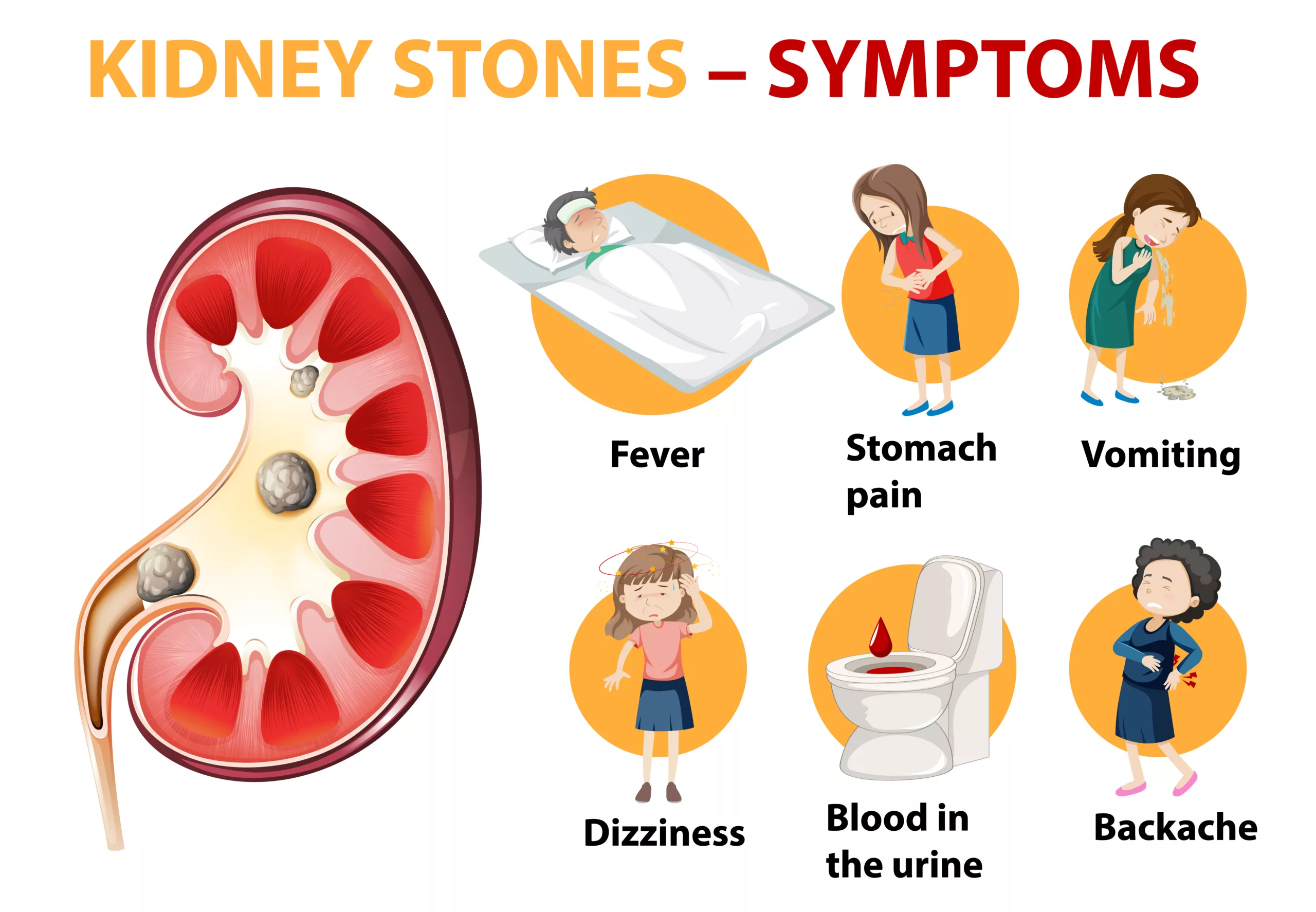Nephrolithiasis, aka “Kidney Stones, Renal Canculi,” is a prevalent and excruciating condition that affects millions of individuals worldwide. The condition results from mineral deposits traveling from the kidneys through the ureters. Depending on their location within the urinary system, these deposits can be slightly or severely painful. It’s important to comprehend this condition for prompt diagnosis and effective treatment.

What is Nephrolithiasis?
Nephrolithiasis refers to the condition of having kidney stones. These stones contain salts and minerals, including struvite, calcium phosphate, uric acid, and calcium oxalate. They can occur anywhere in the urinary tract, including the kidneys, ureters, bladder, and urethra. Their size can range from a grain of sand to a golf ball. Small stones are easier to pass through the urine, whereas larger stones are painful. Even though passing a kidney stone might be unpleasant, with the right fluids and pain relief, it typically goes away on its own. However, larger stones, or those that block the passage of urine, can necessitate medical attention.
Pathophysiology
The precise reason for kidney stone production can vary depending on the type of stone. The following are various factors that contribute to the formation of kidney stones:
Urine Supersaturation:
Certain minerals, like calcium, phosphorus, etc., crystallize when concentrated in the urine above a certain limit.
Nucleation:
Nucleation is the initial step in kidney stone formation. After the minerals get concentrated, the initial crystal serves as the center for additional crystal aggregation.
Inhibitors & Promoters:
Urine chemicals that prevent or enhance crystal formation and stone development are known as inhibitors and promoters.
Causes of Nephrolithiasis
The etiology of Nephrolithiasis is multidimensional. Various factors that may lead to Nephrolithiasis are stated below:
Pathologic Predisposition:
Various pathologic causes of Nephrolithiasis include:
Hyperparathyroidism
This disorder results in an excess of parathyroid hormone synthesis1. Shlapack, M. A., Rizvi, A. A., & Lopez, F. A. (2012). Normocalcemic primary hyperparathyroidism characteristics and clinical significance of an emerging entity. The American journal of the medical sciences, 343(2), 163–166. https://doi.org/10.1097/MAJ.0b013e31823bbb9b[. This can raise blood and urine calcium levels, leading to calcium stones forming in the kidneys.
Cystinuria
It is a genetic condition that results in higher levels of amino acid cysteine in the urine. Increased cysteine levels can also cause kidney stones.
Chronic Renal Disease
Chronic kidney diseases disrupt normal renal function and raise the risk of kidney stones.
Medicinal Predisposition:
Different medicines cause Nephrolithiasis. For example;
Diuretics
Diuretics are medications that increase urine production, leading to the removal of excess water and potentially an increase in the concentration of substances like uric acid. Elevated uric acid levels in the urine can contribute to the formation of kidney stones.
Painkillers
Intake of over-the-counter painkillers like Ibuprofen and Aspirin is very casual nowadays. But little do people know that the long-term use of these painkillers can raise the risk of kidney stones.
Family history, Age, and Gender:
If someone has a family history of kidney stones, they are at increased risk of having Nephrolithiasis. Moreover, older adults, particularly men, are also at greater risk of getting kidney stones.
Risk Factors for Nephrolithiasis
Risk factors associated with Nephrolithiasis (kidney stones) are:
- A diet rich in animal protein like red meat, chicken, and eggs increases calcium oxalate and uric acid levels, eventually causing kidney stones.
- A high-salt diet causes dehydration and increases the excretion of calcium. These two conditions are ideal for making kidney stones.
- Leafy-green vegetables like spinach are rich in oxalates and can lead to the formation of oxalate stones21. Nirumand, M. C., Hajialyani, M., Rahimi, R., Farzaei, M. H., Zingue, S., Nabavi, S. M., & Bishayee, A. (2018). Dietary Plants for the Prevention and Management of Kidney Stones: Preclinical and Clinical Evidence and Molecular Mechanisms. International journal of molecular sciences, 19(3), 765. https://doi.org/10.3390/ijms19030765
- Dehydration is the most common cause of kidney stones in the elderly population. This is because degradation concentrates urine. The concentrated urine in the kidney can form kidney stones. Drinking 8-10 glasses of water a day can decrease the risk of getting kidney stones. Remember, your aim is light yellow urine. Dark urine with froth or a foul smell is alarming, and you should contact your physician immediately!
- Coffee and tea might seem pleasant and tempting to drink daily, but these drinks also cause dehydration and increase urine production3Yuan, S., & Larsson, S. C. (2022). Coffee and Caffeine Consumption and Risk of Kidney Stones: A Mendelian Randomization Study. American journal of kidney diseases: the official journal of the National Kidney Foundation, 79(1), 9–14.e1. https://doi.org/10.1053/j.ajkd.2021.04.018. To prevent the damage caused by these drinks, remember, “Moderation is the Key.” Keep yourself hydrated and take caffeine in moderation.
- Moreover, certain sugary beverages like sodas and juices can also cause dehydration and worsen the risk of kidney stones.

What are the Symptoms of Nephrolithiasis?
Here are the common complaints of patients with Nephrolithiasis:
Extreme Pain
Location: It is usually a sharp pain originating around your back, flank, and the space beneath your ribs. Afterward, the pain may radiate down to your groin, making it difficult to identify its source.
Intensity: A kidney stone’s pain is sometimes characterized as “unbearable,” “wave-like,” or “colicky,” denoting that it comes and goes in short bursts of extreme intensity.
Movement: Moving, bumping, or sitting still might worsen the pain. It might be almost impossible to find a comfortable position at times.

Blood in Urine (Hematuria)
Your urine may appear dark red or have a faint pink tint. The size and position of the stone also affect how much blood is present in the urine. As the stone passes through your urinary tract, it may irritate the lining of the ureters, resulting in bleeding. Your urine subsequently becomes reddish-colored. Hematuria is also an indication of an impending danger that can further damage the kidneys as well. Patients experiencing hematuria should seek immediate medical attention.
Urine Frequency and Urgency
In Nephrolithiasis, there’s a constant urge to pass the urine. Even if you have just passed the urine, you’ll again experience a persistent urge to go to the toilet again. This thing is frustrating, and it can also disrupt your daily schedule.
On the contrary, the urine amount in Nephrolithiasis is very scanty. Although the patient may feel the urgency to void, the urine excreted is very low in amount.
Dysuria
Dysuria means pain while excreting urine. A burning or stinging feeling may also accompany it. The reason is that while passing the urine, stones may irritate the lining of the urinary tract. In contrast, your bladder may empty more slowly than normal due to a hesitant or feeble pee stream.
Nausea & Vomiting
Nephrolithiasis patients also experience nausea and vomiting with the above-stated symptoms.
Types of Kidney Stones
There are various types of kidney stones:
Calcium Oxalate Stones
These are the most common types of kidney stones. Oxalate is commonly found in tomato seeds and forms within the human body.
Calcium Phosphate Stone
As the name suggests, these stones are formed from calcium and phosphate. These usually form when the pH of the urine remains high continuously.
Uric Acid Stones
Uric acid stones are a common presentation in people suffering from gout. In addition to that, a purine-rich diet also leads to the formation of uric acid stones.
Struvite Stones
Struvite stones are also known as infection stones. They are usually formed in the presence of ammonia-forming bacteria. Urinary tract infections also contribute to the formation of struvite stones.
Diagnosis & Evaluation of Nephrolithiasis
To diagnose if someone has kidney stones requires a thorough check-up. Analysis of health history and doing tests like CT scans or ultrasounds helps find out if they have kidney stones. These studies also tell where the stone is located in their body. A urine test helps spot blood or crystals. Blood tests check kidney function and other body changes that can lead to stone formation. Identifying kidney stones early and accurately allows quick actions to prevent the symptoms from aggravating.
What Complications can occur due to kidney stones?
Following complications can occur as a result of Nephrolithiasis:
Obstruction
Stones in the ureter can cause pain and might lead to problems other problems. Hydronephrosis(increase in the size of kidneys) and pyelonephritis(infection in kidneys) may occur.
Infection
Kidney stones aid bacteria to colonize and become a cause of infection.
Renal Impairment
Long-term blockage or repeated formation of stones can harm the kidneys, leading to ongoing kidney disease.
Perforation
Sometimes, varied sizes of kidney stones may perforate the ureter(pee tube). Therefore, medical assistance becomes mandatory when kidney stones are suspected.
How is Nephrolithiasis treated?
The course of treatment for Nephrolithiasis is determined by the size, location, and intensity of the stone and the symptoms. Pain control and hydration are the mainstays of treatment for most tiny stones that go away on their own4Fontenelle, L. F., & Sarti, T. D. (2019). Kidney Stones: Treatment and Prevention. American Family Physician, 99(8), 490–496.. This could include:
- Over-the-counter analgesics can be used to treat the pain of kidney stones.
- Drinking enough water can help remove the tiny stones from the body.
- Your doctor may advise you on specific meal plans and suggest you avoid foods that cause stones to develop.
Hydration therapy is not enough for larger stones to manage the condition, so other medical interventions are required. Here are the different treatment options available for Nephrolithiasis:
Ureteroscopy
It is a minimally invasive treatment that involves inserting a narrow telescope through the urethra to reach the stone.5Tseng TY, Preminger GM. Kidney stones: flexible ureteroscopy. BMJ Clin Evid. 2015 Oct 30;2015:2003. PMID: 26535802; PMCID: PMC4632914. It utilizes ultrasonic or laser radiation to break the stones. Then, tiny pieces of stones are passed into the urine.
Percutaneous nephrolithotomy
This procedure involves making a small incision in the back to reach the kidney and extract the stone directly.
Extracorporeal shock wave lithotripsy (ESWL)
High-energy sound waves are used in ESWL. It is also a non-invasive technique to break up the stone into smaller fragments that are easier to pass through.
Inhibitors & Promoters
Inhibitors and promoter play a major role in case of nephrolithiasis.
Inhibitors Of Nephrolithiasis
As the name suggests, inhibitors inhibit the formation of kidney stones. For example, citrate prevents nephrolithiasis by binding to calcium. This does not let the calcium crystals to form which are a major component of kidney stones. In addition to citrate, magnesium also prevents the formation of calcium oxalate crystals. Therefore, citrate and magnesium are natural inhibitors of nephrolithiasis.
Promoter of Nephrolithiasis
Calcium, oxalate and uric acid are promoters of nephrolithiasis. Increased intake of calcium supplements may lead to their deposition and contribution to formation of kidney stones. Moreover, in conditions like gout, uric acid crystals may deposit in kidneys. Similarly, oxalate is found naturally in tomato seeds, beets and nuts. Excessive consumption of these foods may lead to deposition of oxalate crystals.
Non-Obstructing Nephrolithiasis
Do you know that not all kidney stones cause urinary obstruction? With appropriate hydration and pain control, small stones that are not impeding the flow of urine may pass on their own without needing therapy. It is advised that you see your doctor regularly to track the development of the stone and avoid any more difficulties6Neisius, A., Thomas, C., Roos, F. C., Hampel, C., Fritsche, H. M., Bach, T., Thüroff, J. W., & Knoll, T. (2015). Asymptomatische Nierensteine: Wann Active Surveillance, wann Therapie? [Asymptomatic kidney stones: active surveillance vs. treatment]. Aktuelle Urologie, 46(5), 391–394. https://doi.org/10.1055/s-0035-1559651.
Urolithiasis vs Nephrolithiasis
While Nephrolithiasis refers exclusively to stones generated within the kidneys, urolithiasis is a more general word that refers to stones anywhere in the urinary tract7Bartges, J. W., & Callens, A. J. (2015). Urolithiasis. The Veterinary clinics of North America. Small animal practice, 45(4), 747–768. https://doi.org/10.1016/j.cvsm.2015.03.001. So, you can say Nephrolithiasis is a subtype of urolithiasis. Urolithiasis can also manifest as bladder stones, urethral stones, or ureterolithiasis (stones in the ureters).
Pyelonephritis vs Nephrolithiasis
A kidney illness known as pyelonephritis is frequently brought on by germs that occupy the lower urinary tract. Although they are not the same ailment, kidney stones can raise the risk of pyelonephritis by obstructing the urine’s flow and providing a haven for bacteria8Ciccarese, F., Brandi, N., Corcioni, B., Golfieri, R., & Gaudiano, C. (2021). Complicated pyelonephritis associated with chronic renal stone disease. La Radiologia medica, 126(4), 505–516. https://doi.org/10.1007/s11547-020-01315-7. Nephrolithiasis primarily manifests as flank discomfort, blood in the urine, and urgency while urinating, but pyelonephritis usually causes fever, chills, flank pain, and burning when urinating.
To sum it up, Nephrolithiasis is a common and uncomfortable condition. Larger stones or those causing considerable obstruction require medical attention, although most tiny stones pass on their own with appropriate hydration and pain treatment. Nephrolithiasis can be effectively managed and prevented from recurring if you know the risk factors, causes, symptoms, and available treatments. Recall that maintaining optimal urinary tract health and preventing kidney stones requires a healthy lifestyle and routine doctor’s visits.
Refrences
- 1. Shlapack, M. A., Rizvi, A. A., & Lopez, F. A. (2012). Normocalcemic primary hyperparathyroidism characteristics and clinical significance of an emerging entity. The American journal of the medical sciences, 343(2), 163–166. https://doi.org/10.1097/MAJ.0b013e31823bbb9b[
- 21. Nirumand, M. C., Hajialyani, M., Rahimi, R., Farzaei, M. H., Zingue, S., Nabavi, S. M., & Bishayee, A. (2018). Dietary Plants for the Prevention and Management of Kidney Stones: Preclinical and Clinical Evidence and Molecular Mechanisms. International journal of molecular sciences, 19(3), 765. https://doi.org/10.3390/ijms19030765
- 3Yuan, S., & Larsson, S. C. (2022). Coffee and Caffeine Consumption and Risk of Kidney Stones: A Mendelian Randomization Study. American journal of kidney diseases: the official journal of the National Kidney Foundation, 79(1), 9–14.e1. https://doi.org/10.1053/j.ajkd.2021.04.018
- 4Fontenelle, L. F., & Sarti, T. D. (2019). Kidney Stones: Treatment and Prevention. American Family Physician, 99(8), 490–496.
- 5Tseng TY, Preminger GM. Kidney stones: flexible ureteroscopy. BMJ Clin Evid. 2015 Oct 30;2015:2003. PMID: 26535802; PMCID: PMC4632914.
- 6Neisius, A., Thomas, C., Roos, F. C., Hampel, C., Fritsche, H. M., Bach, T., Thüroff, J. W., & Knoll, T. (2015). Asymptomatische Nierensteine: Wann Active Surveillance, wann Therapie? [Asymptomatic kidney stones: active surveillance vs. treatment]. Aktuelle Urologie, 46(5), 391–394. https://doi.org/10.1055/s-0035-1559651
- 7Bartges, J. W., & Callens, A. J. (2015). Urolithiasis. The Veterinary clinics of North America. Small animal practice, 45(4), 747–768. https://doi.org/10.1016/j.cvsm.2015.03.001
- 8Ciccarese, F., Brandi, N., Corcioni, B., Golfieri, R., & Gaudiano, C. (2021). Complicated pyelonephritis associated with chronic renal stone disease. La Radiologia medica, 126(4), 505–516. https://doi.org/10.1007/s11547-020-01315-7

